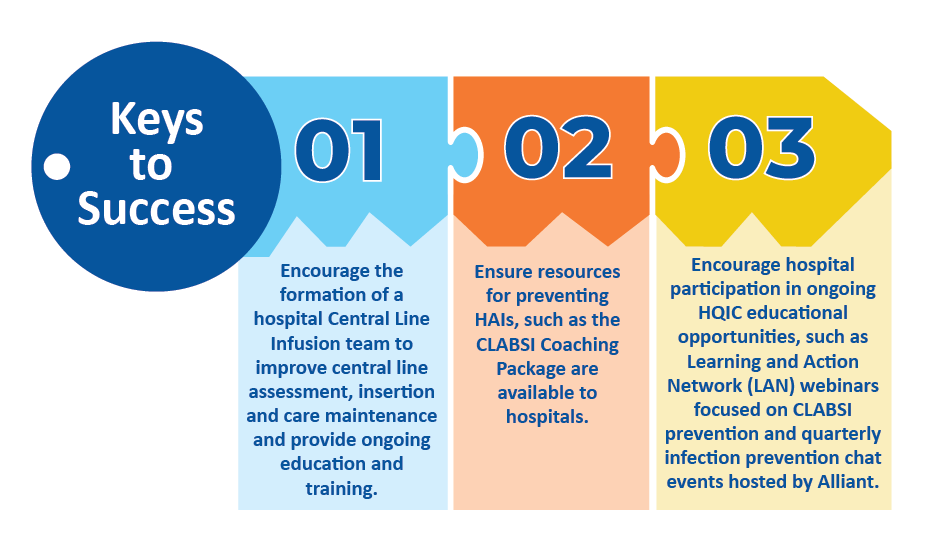The Centers for Medicare & Medicaid Services (CMS) Quality Improvement Organization (QIO) Program is dedicated to improving the quality of health care at the community level. Hospital Quality Improvement Contractors (HQICs) are strategic partners of the QIO Program that support this mission within hospitals by helping clinical teams increase patient safety, particularly preventing hospital-acquired infections (HAIs). Alliant Health Solutions (Alliant) is an HQIC that focuses on helping the 147 enrolled hospitals in their multistate region improve the quality of care and outcomes for patients. Alliant’s goal is to help hospitals reach and maintain zero cases of Central Line-associated Bloodstream Infections (CLABSI).
A large rural hospital in Georgia began working with Alliant to reduce its CLABSI rate in June of 2022. In conjunction with a Georgia Hospital Association (GHA) quality improvement coach and the hospital, Alliant conducted a root-cause analysis. The analysis revealed that a large group of physicians and nurses participated in the insertion, maintenance, and removal of Central Venous Catheters (CVCs) and Peripherally Inserted Center Catheters (PICCs). Inconsistencies with insertion may have contributed to an increase in infections. To address these inconsistencies, the hospital developed a Central Line Infusion team.
When Alliant began working with the hospital, it had a baseline of five CLABSI cases (October 2020 – September 2021). With the assistance of the quality improvement coach, Alliant’s resources, and the Central Line Infusion team, the hospital achieved a Standard Infection Ratio (SIR) of 0.67 and a 71.43 percent relative improvement rate (RIR) as of October 2022. There were three CLABSIs avoided, and a methodology recommended by CMS, based on the White Paper, Draft Final Report Estimating the Additional Hospital Inpatient Cost and Mortality Associated with Selected Hospital Acquired Conditions[1], estimated a cost savings of $165,398. As of April 2023, the hospital is maintaining a 0.00 percent SIR with a 100 percent RIR.
Forming a Central Line Infusion Team and Implementing Recommended CLABSI Interventions
The hospital’s Central Line Infusion team, led by a physician champion, is comprised of nurses and physicians who insert CVCs and PICCs with the goal of reducing the number of CLABSI infections. The GHA quality improvement coach provided education and training to the hospital’s infection preventionist via coaching calls who then trained the infusion team through group and one-on-one learning on the following:
• Use of sterile barrier precautions for CVCs and PICCs
• Insertion, maintenance and indications for intravascular catheter use
• Avoiding the use of the femoral vein for central venous access in adult patients
• Proper removal of any intravascular catheter that is no longer essential
The intent of these efforts was to ensure strict adherence to evidence-based best practices by limiting the placement, maintenance and removal of CVCs and PICCs to a highly trained team of experts.
Interventions were supported by Alliant’s Making Health Care Better Together CLABSI Coaching Package which includes evidence-based best practices and resources to create quality improvement action plans. Education, training and staffing, selection of catheters and sites and maximal sterile barrier precautions are a few examples of the resources in the coaching package.
Compliance with these protocols were monitored by nursing staff and audited through direct observation by the physician champion. Direct observation of insertions on the unit allowed just-in-time staff education and additional training if needed. Ongoing skills education and resources were provided by Alliant and annual competencies were completed by the hospital infection preventionist to assess the knowledge and capability of the infusion team. A concurrent and retrospective review of the hospital’s catheter utilization data was completed by the Central Line Infusion team. Discussions about removing central lines, successes and other related updates were shared during daily huddles, direct observations, team meetings and quality/medical staff and board meetings.
Participating in Ongoing CLABSI Education
In addition to the training and education provided to the infection preventionist and the Central Line Infusion team, the hospital’s quality manager and director of quality attended one-on-one monthly coaching sessions with the GHA quality improvement coach to review best practice interventions and the CLABSI Coaching Package. They also attended Alliant’s Office Hours/Infection Prevention Chats led by Alliant’s infection preventionists. These events are intended to provide networking opportunities for participants to build knowledge, share experiences and find support. Additionally, they participated in Alliant’s Catheter-Associated Urinary Tract Infection Prevention in Action: Strategies from the Field event that featured real-world examples of effective CAUTI prevention strategies shared by infection prevention leaders.
Keys to Success
Alliant’s success can be replicated by taking the following steps:

For more information, visit Alliant HQIC.
This material was prepared by The Bizzell Group (Bizzell), the Data Validation and Administrative (DVA) contractor, under contract with the Centers for Medicare & Medicaid Services (CMS), an agency of the U.S. Department of Health and Human Services (HHS). Views expressed in this material do not necessarily reflect the official views or policy of CMS or HHS, and any reference to a specific product or entity herein does not constitute endorsement of that product or entity by CMS or HHS. 12SOW/Bizzell/DVA-1173-08/15/23
[1] Bysshe, T., et al. "Estimating the additional hospital inpatient cost and mortality associated with selected hospital‐acquired conditions." (2018).

